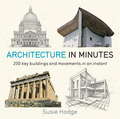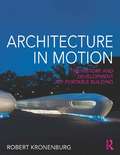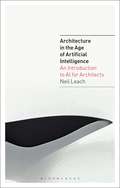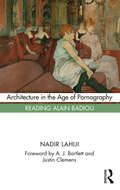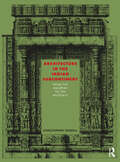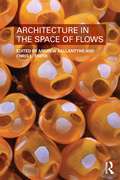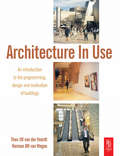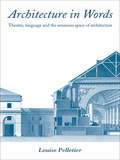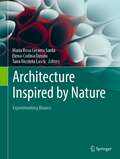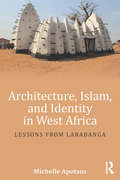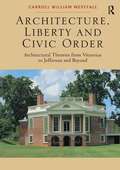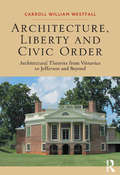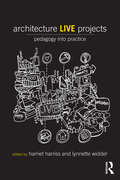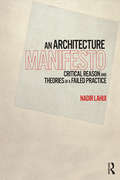- Table View
- List View
Architecture In Minutes (IN MINUTES)
by Susie HodgeIn this hyper-compact, fully illustrated guide to architecture, Susie Hodge outlines the history and theory of architecture from the earliest structures to the cutting-edge concepts of the present day. Along the way she profiles 200 key buildings, historic styles, architectural movements and celebrated architects from all around the world. Contents include the Greek orders, Roman engineering, Gothic architecture, the Renaissance, the Baroque, Revivalism, Art Nouveau, Modernism and Postmodernism, Futurism and Dynamic architecture along with architects like Inigo Jones, Christopher Wren, Gaudi, Frank Lloyd Wright, Le Corbusier and Frank Gehry.
Architecture in Motion: The history and development of portable building
by Robert KronenburgThe idea that architecture can be portable is one that grabs the imagination of both designers and the people who use it, perhaps because it so often forecasts a dynamic and creative solution to the complex problems of our contemporary mobile society, while at the same time dealing with issues of practicality, economy and sustainability. Architecture in Motion examines the development of portable, transportable, demountable and temporary architecture from prehistory to the present day. From familiar vernacular models such as the tent, mobile home and houseboat, to ambitious developments in military and construction engineering, all aspects of portable building are considered. Building on his earlier works Portable Architecture and Houses in Motion, Robert Kronenburg compares traditional forms of building, current commercial products and the work of innovative designers, and examines key contemporary portable buildings to reveal surprising, exciting and imaginative examples. He explores the philosophical and technological issues raised by these experimental and futuristic prototypes. By understanding the nature of transitory architecture, a new ecologically aware design strategy can be developed to prioritise buildings that 'tread lightly on the earth' and still convey the sense of identity and community necessary for an established responsible society. This book provides a unique insight into this pivotal field of design.
Architecture in Motion: The history and development of portable building
by Robert KronenburgThe idea that architecture can be portable is one that grabs the imagination of both designers and the people who use it, perhaps because it so often forecasts a dynamic and creative solution to the complex problems of our contemporary mobile society, while at the same time dealing with issues of practicality, economy and sustainability. Architecture in Motion examines the development of portable, transportable, demountable and temporary architecture from prehistory to the present day. From familiar vernacular models such as the tent, mobile home and houseboat, to ambitious developments in military and construction engineering, all aspects of portable building are considered. Building on his earlier works Portable Architecture and Houses in Motion, Robert Kronenburg compares traditional forms of building, current commercial products and the work of innovative designers, and examines key contemporary portable buildings to reveal surprising, exciting and imaginative examples. He explores the philosophical and technological issues raised by these experimental and futuristic prototypes. By understanding the nature of transitory architecture, a new ecologically aware design strategy can be developed to prioritise buildings that 'tread lightly on the earth' and still convey the sense of identity and community necessary for an established responsible society. This book provides a unique insight into this pivotal field of design.
Architecture in the Age of Artificial Intelligence: An Introduction to AI for Architects (PDF) (Architecture in the age of Artificial Intelligence)
by Neil LeachArtificial intelligence is everywhere from the apps on our phones to the algorithms of search engines. Without us noticing, the AI revolution has arrived. But what does this mean for the world of design? AI and the Design Revolution the first volume in the two-book series Architecture in the Age of Artificial Intelligence introduces AI for designers and considers its positive potential for the future of architecture and design. Explaining what AI is and how it works, the book examines how different manifestations of AI will impact the architectural profession. Highlighting current case-studies as well as near-future applications, it shows how AI is already being used as a powerful design tool, and how AI-driven information systems will soon transform the future of buildings and cities. Far-sighted, provocative and challenging, yet rooted in careful research and cautious speculation, this book, written by architect and theorist Neil Leach, is a must-read for all architects and designers including students of architecture and all design professionals interested in keeping their practice at the cutting edge of technology.
Architecture in the Age of Pornography: Reading Alain Badiou
by Nadir LahijiArchitecture, and its pedagogy in the academy, is dominated by the technology of image production that veils the ‘naked power’ behind its operation. It conforms to the principles of cultural logic of the society of the spectacle, consistent with neoliberal capitalism. The problem with this dominant pedagogy is that it violates the fundamental ethical imperative, putting architecture in direct contradiction with the ‘common good’. In addition, it has let architecture enter the brothel of pornographic capitalism which turns every object into an object of obscene gratification of the senses. In this book, Nadir Lahiji adopts Alain Badiou’s thesis from The Pornographic Age to demonstrate that contemporary architecture is in absolute complicity with the pornographic present. The traits that Badiou identifies in this age are manifestly visible in architectural surfaces which are subordinated to the same ‘regime of images’. Similarly to Badiou’s political indictments of the society which has given rise to the pornographic present, the book condemns the architecture that has lent its service to the same society with a license to consummate its transgression to better cater to the imperative of the ‘regime of images’. Transposing the conceptual categories in Badiou’s analysis to the critique of architecture’s pornographic turn in contemporary society, the book constructs a conceptual framework by which to demonstrate the specific manifestations of pornography in building. The book is aimed at architecture students at higher graduate and post-graduate levels.
Architecture in the Age of Pornography: Reading Alain Badiou
by Nadir LahijiArchitecture, and its pedagogy in the academy, is dominated by the technology of image production that veils the ‘naked power’ behind its operation. It conforms to the principles of cultural logic of the society of the spectacle, consistent with neoliberal capitalism. The problem with this dominant pedagogy is that it violates the fundamental ethical imperative, putting architecture in direct contradiction with the ‘common good’. In addition, it has let architecture enter the brothel of pornographic capitalism which turns every object into an object of obscene gratification of the senses. In this book, Nadir Lahiji adopts Alain Badiou’s thesis from The Pornographic Age to demonstrate that contemporary architecture is in absolute complicity with the pornographic present. The traits that Badiou identifies in this age are manifestly visible in architectural surfaces which are subordinated to the same ‘regime of images’. Similarly to Badiou’s political indictments of the society which has given rise to the pornographic present, the book condemns the architecture that has lent its service to the same society with a license to consummate its transgression to better cater to the imperative of the ‘regime of images’. Transposing the conceptual categories in Badiou’s analysis to the critique of architecture’s pornographic turn in contemporary society, the book constructs a conceptual framework by which to demonstrate the specific manifestations of pornography in building. The book is aimed at architecture students at higher graduate and post-graduate levels.
Architecture in the Indian Subcontinent: From the Mauryas to the Mughals
by Christopher TadgellDedicated to the tracing of continuity across sectarian divides, Christopher Tadgell’s History of Architecture in India (1989) was the first modern monograph to draw together in one volume all the strands of India’s pre-colonial architectural history – from the Vedic and Native traditions of early India, through Hindu, Buddhist, Islamic and secular architecture. This comprehensive revision, Architecture in the Indian Subcontinent: From the Mauryas to the Mughals, expands the structure to acknowledge the great advance in scholarship across this extremely complex subject over the last three decades. An understanding of Indian history and religion is the basis for understanding the complex pattern of relationships in the evolution of architecture in the subcontinent. Therefore, background material covers major invasions, migrations, dynastic conflicts and cultural and commercial connections, the main religious developments and their significance and repercussions, and external architectural precedents. While avoiding the usual division of the subject into ‘Buddhist and Hindu’ and ‘Islamic’ parts in order to trace continuity, the importance of religion, symbolism and myth to the development of characteristic Indian architectural forms in all their richness and complexity is fully explained in this fully illustrated account of the subcontinent’s architecture.
Architecture in the Indian Subcontinent: From the Mauryas to the Mughals
by Christopher TadgellDedicated to the tracing of continuity across sectarian divides, Christopher Tadgell’s History of Architecture in India (1989) was the first modern monograph to draw together in one volume all the strands of India’s pre-colonial architectural history – from the Vedic and Native traditions of early India, through Hindu, Buddhist, Islamic and secular architecture. This comprehensive revision, Architecture in the Indian Subcontinent: From the Mauryas to the Mughals, expands the structure to acknowledge the great advance in scholarship across this extremely complex subject over the last three decades. An understanding of Indian history and religion is the basis for understanding the complex pattern of relationships in the evolution of architecture in the subcontinent. Therefore, background material covers major invasions, migrations, dynastic conflicts and cultural and commercial connections, the main religious developments and their significance and repercussions, and external architectural precedents. While avoiding the usual division of the subject into ‘Buddhist and Hindu’ and ‘Islamic’ parts in order to trace continuity, the importance of religion, symbolism and myth to the development of characteristic Indian architectural forms in all their richness and complexity is fully explained in this fully illustrated account of the subcontinent’s architecture.
Architecture in the Space of Flows
by Andrew Ballantyne Chris L. SmithTraditionally, architecture has been preoccupied with the resolution of form. That concern helps to make photogenic buildings, which have received a great deal of attention. This book looks instead at the idea of the flows, which connects things together and moves between things. It is more difficult to discuss, but more necessary, because it is what makes things work. Architects have to think about flow – the flow of people through buildings, the flow of energy into buildings, and waste out of them – but usually the effects of flow do not find expression. The essays gathered here present a collection of exploratory ideas and offer an understanding of buildings, people and settlements through concepts of flow.
Architecture in the Space of Flows
by Andrew Ballantyne Christopher SmithTraditionally, architecture has been preoccupied with the resolution of form. That concern helps to make photogenic buildings, which have received a great deal of attention. This book looks instead at the idea of the flows, which connects things together and moves between things. It is more difficult to discuss, but more necessary, because it is what makes things work. Architects have to think about flow – the flow of people through buildings, the flow of energy into buildings, and waste out of them – but usually the effects of flow do not find expression. The essays gathered here present a collection of exploratory ideas and offer an understanding of buildings, people and settlements through concepts of flow.
Architecture in Times of Multiple Crises: Embodied Utopianisms of Care and Radical Spatial Practice (Architekturen #73)
by Carolina CrijnsUnder the premise that architecture makes life ›better‹, architecture is often presented as the ›solution‹ to social problems, made ›green‹ when promising sustainable futures, or fetishised as a cultural object for the creation of urban identities. Yet, what is it exactly that links architecture so closely to the pursuit of a good life? How is this link interrelated with crisis and crisis thinking? To what extent do belief systems in architecture influence its capacity to deal with crises? Carolina Crijns not only explores the transformative potential in radically rethinking architecture's central concepts but introduces a method of utopian speculation for practices ambitious of social change. With a preface by Sabine Knierbein.
Architecture In Use
by DJM van der Voordt HBR van WegenThis unique book discusses programming, design and building evaluation providing a ‘joined up’ approach to building design. By linking the functional and architectonic qualities of a building, the authors show the practical implications of the utility value of buildings. Starting by looking at how the relationship between form and function has been dealt with by different approaches to architecture from a historical perspective, it goes on to discuss how the desired functional quality and utility value of a building can be expressed in a brief and given a physical form by the architect. Finally, it advises on how to carry out post-occupancy evaluation and provides the architect with methods and techniques for testing whether the intended utility value of a building has been achieved.
Architecture In Use
by DJM van der Voordt HBR van WegenThis unique book discusses programming, design and building evaluation providing a ‘joined up’ approach to building design. By linking the functional and architectonic qualities of a building, the authors show the practical implications of the utility value of buildings. Starting by looking at how the relationship between form and function has been dealt with by different approaches to architecture from a historical perspective, it goes on to discuss how the desired functional quality and utility value of a building can be expressed in a brief and given a physical form by the architect. Finally, it advises on how to carry out post-occupancy evaluation and provides the architect with methods and techniques for testing whether the intended utility value of a building has been achieved.
Architecture in Words: Theatre, Language and the Sensuous Space of Architecture
by Louise PelletierWhat if the house you are about to enter was built with the confessed purpose of seducing you, of creating various sensations destined to touch your soul and make you reflect on who you are? Could architecture have such power? This was the assumption of generations of architects at the beginning of modernity. Exploring the role of theatre and fiction in defining character in architecture, Louise Pelletier examines how architecture developed to express political and social intent. Applying this to the modern day, Pelletier considers how architects can learn from these eighteenth century attitudes in order to restore architecture's communicative dimension. Through an in-depth and interdisciplinary analysis of the beginning of modernity, Louise Pelletier encourages today's architects to consider the political and linguistic implications of their tools. Combining theory, historical studies and research, Architecture in Words will provoke thought and enrich the work of any architect.
Architecture in Words: Theatre, Language and the Sensuous Space of Architecture
by Louise PelletierWhat if the house you are about to enter was built with the confessed purpose of seducing you, of creating various sensations destined to touch your soul and make you reflect on who you are? Could architecture have such power? This was the assumption of generations of architects at the beginning of modernity. Exploring the role of theatre and fiction in defining character in architecture, Louise Pelletier examines how architecture developed to express political and social intent. Applying this to the modern day, Pelletier considers how architects can learn from these eighteenth century attitudes in order to restore architecture's communicative dimension. Through an in-depth and interdisciplinary analysis of the beginning of modernity, Louise Pelletier encourages today's architects to consider the political and linguistic implications of their tools. Combining theory, historical studies and research, Architecture in Words will provoke thought and enrich the work of any architect.
Architecture Inspired by Nature: Experimenting Bionics
by María Rosa Cervera Sardá Elena-Codina Dușoiu Tana Nicoleta LascuThe book brings together the research completed during 10 editions of International Seminars of Bionics, organized by the School of Architecture of the University of Alcalá de Henares, Madrid, several of them in partnership with the “Ion Mincu” University of Architecture and Urbanism, Bucharest, carried out in Spain and in Romania. The articles here consider advanced bionic design principles, implementing them to an impressive variety of application fields, including, but not limited to, urban planning and landscape, public space, architecture and building structures, design and detailing, application of natural dynamic processes, bio-digital architecture, innovative materials based on living organisms (micro-algae), and nano-modified materials. A particular focus is given to light and perception of light. To illustrate the principles developed, this contributed volume includes descriptions and full-color images of the experimental projects created during the workshops held in the framework of these ISB meetings: Learning from Nature, Integrating Bionics (2009); Adaptability, Efficiency and Biostructures (2010); Bionics and Innovation (2011); Forms and Structures Inspired by Nature (2016, 2017); Furniture Inspired by Natural Models (2018); Relation between Structure and Envelope: Light Structures (2019); Light, from Nature to Architecture. Structures Inspired in Nature (2020); Light in Architecture and Design: A Bionic Perspective (2021); Sustainable Thinking and Bionics (2022).
Architecture, Islam, and Identity in West Africa: Lessons from Larabanga
by Michelle ApotsosArchitecture, Islam, and Identity in West Africa shows you the relationship between architecture and Islamic identity in West Africa. The book looks broadly across Muslim West Africa and takes an in-depth study of the village of Larabanga, a small Muslim community in Northern Ghana, to help you see how the built environment encodes cultural history through form, material, and space, creating an architectural narrative that outlines the contours of this distinctive Muslim identity. Apotsos explores how modern technology, heritage, and tourism have increasingly affected the contemporary architectural character of this community, revealing the village’s current state of social, cultural, and spiritual flux. More than 60 black and white images illustrate how architectural components within this setting express the distinctive narratives, value systems, and realities that make up the unique composition of this Afro-Islamic community.
Architecture, Islam, and Identity in West Africa: Lessons from Larabanga
by Michelle ApotsosArchitecture, Islam, and Identity in West Africa shows you the relationship between architecture and Islamic identity in West Africa. The book looks broadly across Muslim West Africa and takes an in-depth study of the village of Larabanga, a small Muslim community in Northern Ghana, to help you see how the built environment encodes cultural history through form, material, and space, creating an architectural narrative that outlines the contours of this distinctive Muslim identity. Apotsos explores how modern technology, heritage, and tourism have increasingly affected the contemporary architectural character of this community, revealing the village’s current state of social, cultural, and spiritual flux. More than 60 black and white images illustrate how architectural components within this setting express the distinctive narratives, value systems, and realities that make up the unique composition of this Afro-Islamic community.
Architecture, Liberty and Civic Order: Architectural Theories from Vitruvius to Jefferson and Beyond (PDF)
by Carroll William WestfallThis book brings to light central topics that are neglected in current histories and theories of architecture and urbanism. These include the role of imitation in earlier centuries and its potential role in present practice; the necessary relationship between architecture, urbanism and the rural districts; and their counterpart in the civil order that builds and uses what is built. The narrative traces two models for the practice of architecture. One follows the ancient model in which the architect renders his service to serve the interests of others; it survives and is dominant in modernism. The other, first formulated in the fifteenth century by Leon Battista Alberti, has the architect use his talent in coordination with others to contribute to the common good of a republican civil order that seeks to protect its own liberty and that of its citizens. Palladio practiced this way, and so did Thomas Jefferson when he founded a uniquely American architecture, the counterpart to the nation’s founding. This narrative gives particular emphasis to the contrasting developments in architecture on the opposite sides of the English Channel. The book presents the value for clients and architects today and in the future of drawing on history and tradition. It stresses the importance, indeed, the urgency, of restoring traditional practices so that we can build just, beautiful, and sustainable cities and rural districts that will once again assist citizens in living not only abundantly but also well as they pursue their happiness.
Architecture, Liberty and Civic Order: Architectural Theories from Vitruvius to Jefferson and Beyond
by Carroll William WestfallThis book brings to light central topics that are neglected in current histories and theories of architecture and urbanism. These include the role of imitation in earlier centuries and its potential role in present practice; the necessary relationship between architecture, urbanism and the rural districts; and their counterpart in the civil order that builds and uses what is built. The narrative traces two models for the practice of architecture. One follows the ancient model in which the architect renders his service to serve the interests of others; it survives and is dominant in modernism. The other, first formulated in the fifteenth century by Leon Battista Alberti, has the architect use his talent in coordination with others to contribute to the common good of a republican civil order that seeks to protect its own liberty and that of its citizens. Palladio practiced this way, and so did Thomas Jefferson when he founded a uniquely American architecture, the counterpart to the nation’s founding. This narrative gives particular emphasis to the contrasting developments in architecture on the opposite sides of the English Channel. The book presents the value for clients and architects today and in the future of drawing on history and tradition. It stresses the importance, indeed, the urgency, of restoring traditional practices so that we can build just, beautiful, and sustainable cities and rural districts that will once again assist citizens in living not only abundantly but also well as they pursue their happiness.
Architecture, Liberty and Civic Order: Architectural Theories from Vitruvius to Jefferson and Beyond
by Carroll William WestfallThis book brings to light central topics that are neglected in current histories and theories of architecture and urbanism. These include the role of imitation in earlier centuries and its potential role in present practice; the necessary relationship between architecture, urbanism and the rural districts; and their counterpart in the civil order that builds and uses what is built. The narrative traces two models for the practice of architecture. One follows the ancient model in which the architect renders his service to serve the interests of others; it survives and is dominant in modernism. The other, first formulated in the fifteenth century by Leon Battista Alberti, has the architect use his talent in coordination with others to contribute to the common good of a republican civil order that seeks to protect its own liberty and that of its citizens. Palladio practiced this way, and so did Thomas Jefferson when he founded a uniquely American architecture, the counterpart to the nation’s founding. This narrative gives particular emphasis to the contrasting developments in architecture on the opposite sides of the English Channel. The book presents the value for clients and architects today and in the future of drawing on history and tradition. It stresses the importance, indeed, the urgency, of restoring traditional practices so that we can build just, beautiful, and sustainable cities and rural districts that will once again assist citizens in living not only abundantly but also well as they pursue their happiness.
Architecture, Liberty and Civic Order: Architectural Theories from Vitruvius to Jefferson and Beyond
by Carroll William WestfallThis book brings to light central topics that are neglected in current histories and theories of architecture and urbanism. These include the role of imitation in earlier centuries and its potential role in present practice; the necessary relationship between architecture, urbanism and the rural districts; and their counterpart in the civil order that builds and uses what is built. The narrative traces two models for the practice of architecture. One follows the ancient model in which the architect renders his service to serve the interests of others; it survives and is dominant in modernism. The other, first formulated in the fifteenth century by Leon Battista Alberti, has the architect use his talent in coordination with others to contribute to the common good of a republican civil order that seeks to protect its own liberty and that of its citizens. Palladio practiced this way, and so did Thomas Jefferson when he founded a uniquely American architecture, the counterpart to the nation’s founding. This narrative gives particular emphasis to the contrasting developments in architecture on the opposite sides of the English Channel. The book presents the value for clients and architects today and in the future of drawing on history and tradition. It stresses the importance, indeed, the urgency, of restoring traditional practices so that we can build just, beautiful, and sustainable cities and rural districts that will once again assist citizens in living not only abundantly but also well as they pursue their happiness.
Architecture Live Projects: Pedagogy into Practice
by Harriet Harriss Lynnette WidderArchitecture Live Projects provides a persuasive, evidence-based advocacy for moving a particular kind of architectural learning, known as Live Projects, towards a holistic integration into current and future architectural curricula. Live Projects are work completed in the borderlands between architectural education and built environment practice; they include design/build work, community-based design, urban advocacy consulting and a host of other forms and models described by the book’s international group of authors. Because of their position, Live Projects as vehicle for simultaneously providing teaching and service has the potential to recalibrate the contesting claims that both academia and profession make to architecture. This collection of essays and case studies consolidates current discussions on theory and learning ambitions, academic best practices, negotiation with licensure and accreditation, and considerations of architectural integrity. It is an invaluable resource to current and future Live Projects advocates – whether they aim to move from pedagogy into practice or practice into pedagogy.
Architecture Live Projects: Pedagogy into Practice
by Harriet Harriss Lynnette WidderArchitecture Live Projects provides a persuasive, evidence-based advocacy for moving a particular kind of architectural learning, known as Live Projects, towards a holistic integration into current and future architectural curricula. Live Projects are work completed in the borderlands between architectural education and built environment practice; they include design/build work, community-based design, urban advocacy consulting and a host of other forms and models described by the book’s international group of authors. Because of their position, Live Projects as vehicle for simultaneously providing teaching and service has the potential to recalibrate the contesting claims that both academia and profession make to architecture. This collection of essays and case studies consolidates current discussions on theory and learning ambitions, academic best practices, negotiation with licensure and accreditation, and considerations of architectural integrity. It is an invaluable resource to current and future Live Projects advocates – whether they aim to move from pedagogy into practice or practice into pedagogy.
An Architecture Manifesto: Critical Reason and Theories of a Failed Practice
by Nadir LahijiWhat is a manifesto? In basic terms, a manifesto is ‘the invention of future for the present’. We have been oblivious to the fact that the twentieth century was the century of manifestos. It was the century of programmatic declarations, radical and avant-garde political, artistic and architectural proclamations. Manifestos came to be a genre of concise and radical-critical writings exposing the repressed contradictions in a dominant doctrine. They opened up the present to the future by denouncing the forces of the status quo and offering alternative programs. Today, this genre is a more valid, even urgent, form of writing for our time, in order to expose the dominant doctrine that has closed the future in subscribing to the ideology of the ‘end of history’. In this manifesto, Nadir Lahiji takes a leap of faith. It is a faith in Lost Causes. He asserts that today, architectonic reason has fallen into ruins. As soon as architecture leaves the limits set to it by architectonic reason, no other path is open to it but the path to aestheticism. This is the wrong path contemporary architecture has taken. In its reduction to a pure aesthetic object, architecture negatively affects the human sensorium. Capitalist consumer society creates desires by generating ‘surplus-enjoyment’ for capitalist profit and contemporary architecture has become an instrument in generating this ‘surplus-enjoyment’, with fatal consequences. This manifesto is thus both a critique and a work of theory. It is a siren, alarm, klaxon to the current status quo within architectural discourse and a timely response to the conditions of architecture today.
